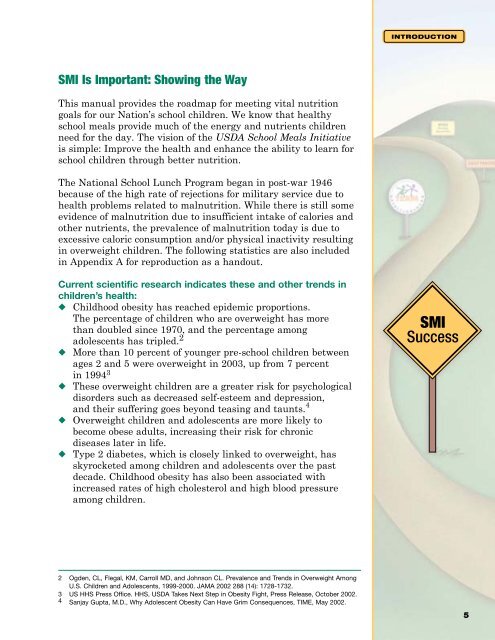Road to SMI Success Manual - Region 10 Education Service Center
Road to SMI Success Manual - Region 10 Education Service Center
Road to SMI Success Manual - Region 10 Education Service Center
Create successful ePaper yourself
Turn your PDF publications into a flip-book with our unique Google optimized e-Paper software.
Introduction<br />
<strong>SMI</strong> Is Important: Showing the Way<br />
This manual provides the roadmap for meeting vital nutrition<br />
goals for our Nation’s school children. We know that healthy<br />
school meals provide much of the energy and nutrients children<br />
need for the day. The vision of the USDA School Meals Initiative<br />
is simple: Improve the health and enhance the ability <strong>to</strong> learn for<br />
school children through better nutrition.<br />
The National School Lunch Program began in post-war 1946<br />
because of the high rate of rejections for military service due <strong>to</strong><br />
health problems related <strong>to</strong> malnutrition. While there is still some<br />
evidence of malnutrition due <strong>to</strong> insufficient intake of calories and<br />
other nutrients, the prevalence of malnutrition <strong>to</strong>day is due <strong>to</strong><br />
excessive caloric consumption and/or physical inactivity resulting<br />
in overweight children. The following statistics are also included<br />
in Appendix A for reproduction as a handout.<br />
Current scientific research indicates these and other trends in<br />
children’s health:<br />
◆ Childhood obesity has reached epidemic proportions.<br />
The percentage of children who are overweight has more<br />
than doubled since 1970, and the percentage among<br />
adolescents has tripled. 2<br />
◆ More than <strong>10</strong> percent of younger pre-school children between<br />
ages 2 and 5 were overweight in 2003, up from 7 percent<br />
in 1994 3<br />
◆ These overweight children are a greater risk for psychological<br />
disorders such as decreased self-esteem and depression,<br />
and their suffering goes beyond teasing and taunts. 4<br />
◆ Overweight children and adolescents are more likely <strong>to</strong><br />
become obese adults, increasing their risk for chronic<br />
diseases later in life.<br />
◆ Type 2 diabetes, which is closely linked <strong>to</strong> overweight, has<br />
skyrocketed among children and adolescents over the past<br />
decade. Childhood obesity has also been associated with<br />
increased rates of high cholesterol and high blood pressure<br />
among children.<br />
<strong>SMI</strong><br />
<strong>Success</strong><br />
2 Ogden, CL, Flegal, KM, Carroll MD, and Johnson CL. Prevalence and Trends in Overweight Among<br />
U.S. Children and Adolescents, 1999-2000. JAMA 2002 288 (14): 1728-1732.<br />
3 US HHS Press Office. HHS, USDA Takes Next Step in Obesity Fight, Press Release, Oc<strong>to</strong>ber 2002.<br />
4 Sanjay Gupta, M.D., Why Adolescent Obesity Can Have Grim Consequences, TIME, May 2002.

















